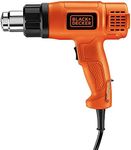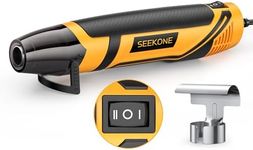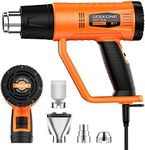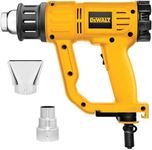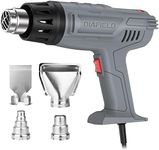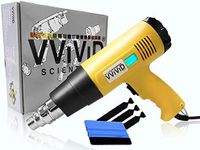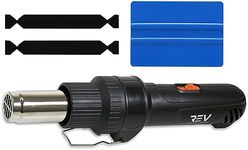Buying Guide for the Best Heat Gun For Vinyl Wrap
Choosing the right heat gun for vinyl wrap projects is important because it can make the process smoother, safer, and more effective. A heat gun helps you stretch and mold vinyl around curves and edges, ensuring a professional finish. When shopping for a heat gun, you should focus on features that make it easy to control the heat and airflow, as well as comfort and safety during use. Understanding the key specifications will help you pick a model that matches your needs, whether you’re a hobbyist or working on larger, more frequent projects.Temperature RangeTemperature range refers to how hot the heat gun can get, usually measured in degrees Celsius or Fahrenheit. This is important because vinyl wrap requires a specific temperature to become flexible without burning or damaging it. Heat guns typically offer a range from around 120°C (250°F) to 600°C (1100°F). Lower ranges are suitable for delicate work or thin vinyl, while higher ranges are better for thicker materials or quick jobs. If you mostly work with standard car vinyl, a mid-range temperature is usually enough. If you plan to use the heat gun for other tasks, like paint removal, a wider range might be useful.
Temperature ControlTemperature control is about how precisely you can set or adjust the heat. Some heat guns have just two or three fixed settings, while others offer a dial or digital display for more precise control. Precise control is important for vinyl wrapping because too much heat can damage the material, while too little won’t make it flexible enough. If you’re new to vinyl wrapping, a model with more control options can help you avoid mistakes and get better results.
Airflow SettingsAirflow settings determine how much hot air the gun blows out, usually measured in liters per minute (L/min) or cubic feet per minute (CFM). Adjustable airflow helps you control how quickly the vinyl heats up and how much area you can cover at once. Lower airflow is good for detailed work or small areas, while higher airflow is better for larger surfaces. If you plan to wrap both small and large areas, look for a heat gun with multiple airflow settings.
Nozzle AttachmentsNozzle attachments are different shapes and sizes of tips that direct the heat in specific ways. Some heat guns come with a variety of nozzles, like wide, narrow, or reflector types. These help you focus the heat for detailed work or spread it out for larger areas. If you want versatility and cleaner results, choose a heat gun that includes several nozzle options or allows you to buy them separately.
Ergonomics and WeightErgonomics and weight refer to how comfortable and easy the heat gun is to hold and use, especially for long periods. A lightweight, well-balanced heat gun with a comfortable grip will reduce hand fatigue and make it easier to control the tool. If you expect to work on large projects or use the heat gun often, prioritize models that feel good in your hand and are not too heavy.
Safety FeaturesSafety features include things like automatic shut-off, cool-down settings, and heat shields. These features help prevent accidents, overheating, or burns. For beginners or anyone working in a busy environment, safety features add peace of mind and reduce the risk of injury or damage to your work area.
